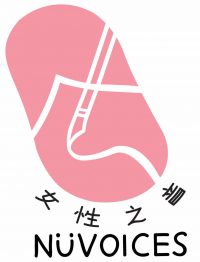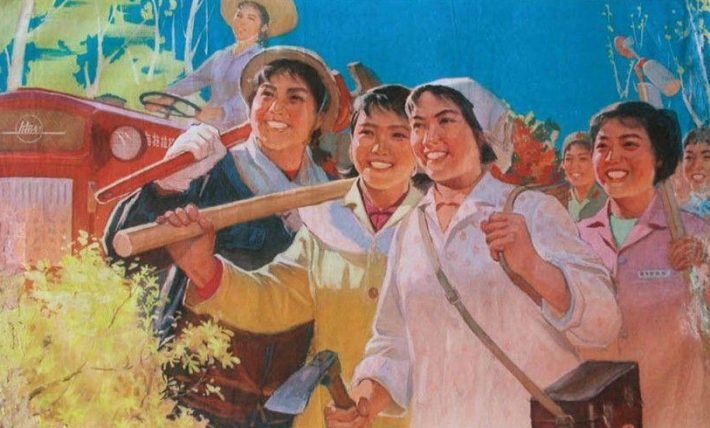BY EMILY MATSON
China’s feminist activism has blossomed against all odds to become one of the country’s most dynamic social movements. However, this phenomenon didn’t emerge from a vacuum. Rather, it was built on the backs of feminist activists that began grappling with gender inequality in China decades ago – activists who were motivated by specific sociopolitical concerns dating back to the early to mid-twentieth century.
During the New Culture Movement of 1915-1927 (which has strong links to the May Fourth Movement), for instance, feminist authors were largely concerned with repudiating Confucianism and the rigid social hierarchies that they believed were oppressive towards women and young people alike. Later, during the War of Resistance against Japan, feminist authors departed from the grand narratives of Chinese national salvation to describe everyday life for women during the Japanese invasion and the misogyny suffered at the hands of both Japanese and Chinese men.
Here are 12 recommended readings from the forerunners of Chinese feminism, stretching from the anti-Qing revolutionary Qiu Jin to the famous novelist Eileen Chang:

Qiu Jin, “An Address to My Two Hundred Million Women Compatriots in China” (1904)
Revolutionary feminist martyr Qiu Jin is sometimes referred to as “China’s first feminist,” or even “China’s Joan of Arc.” Known for challenging traditional gender roles, one of Qiu’s primary motivations for plotting the overthrow of the corrupt Qing Dynasty was the dynastic system’s espousal of an antiquated Confucian system that oppressed women. Qiu’s impassioned speech in Japan (a destination for many anti-Qing revolutionaries in the early twentieth century) is notable not only for its fiery rhetoric denouncing misogyny, but also for urging women to liberate themselves through education.
He Zhen, “On the Question of Women’s Liberation” (1907)
Along with her husband, Liu Shipei, He Zhen founded the Society of the Restoration of Women’s Rights, which was a Tokyo-based anti-Qing anarcha-feminist group in the early twentieth century. In the Society’s journal, Natural Justice, He published this essay to encourage the smashing of the patriarchy by ridding society of social and political institutions that repressed women. He strongly believed that the liberation of women must be accomplished by the active initiation of women themselves, rather than by well-intentioned men.
Mao Zedong, “The Suicide of Miss Zhao” (1919)
As a young man during China’s May Fourth Movement, Mao Zedong was deeply influenced by the idealization of modern love relationships between men and women. Many of Mao’s early writings include protests against the unfair treatment of women in traditional Chinese society. In total, he wrote ten pieces in response to the suicide of a young woman from Changsha in Hunan Province, who slit her own throat on her wedding day to escape an arranged marriage. Mao argued that the woman had no choice but to commit suicide, as segregated Chinese society left her with no other option.

Chen Xuezhao, “The New Women of My Ideal” (1923)
The first published work from prolific writer Chen Xuezhao, “The New Women of My Ideal” is a product of the New Woman Movement that developed in China in tandem with the May Fourth Movement. Well known for her support of Mao Zedong’s “Talks at the Yan’an Conference on Arts and Literature,” Chen was directly praised by Mao and officially applied to join the Chinese Communist Party in 1945. Later, she was politically denounced in the 1957 “Anti-Rightist Campaign,” and took a hiatus from writing until after the Cultural Revolution.
Bing Xin, “A Maze of Stars” and “Spring Water” (1923)
At the age of 19, Bing Xin (a penname literally meaning “frozen heart”) published this collection of short poetry, which was heavily influenced by both the New Literature Movement’s use of baihua (vernacular Chinese, rather than literary Chinese) as well as the poetry of Rabindranath Tagore (an influential Bengali polymath who became the first non-European to win the Nobel Prize in Literature). This work explores the themes of childhood and youth (Bing was also a famous writer of children’s literature), nature, and love (both romantic and platonic). Bing was so influential that her style of poetry came to be known simply as the “Bing Xin style.” She continued to write until her death in the 1990s.
Lu Xun, “What Happens After Nora Walks Out” (1923)
Often considered to be China’s most renowned twentieth century author, Lu Xun was an active writer and speaker during the May Fourth Movement. His speech, given at Beijing Women’s Normal College, refers to the character Nora from Hendrik Ibsen’s play “A Doll’s House,” which was extremely influential during the May Fourth Movement, and the hypothetical question of what options Nora might have after she leaves home at the end of the play. Similar to Mao’s argument in “Miss Zhao’s Suicide,” Lu Xun argues that running away would not solve Nora’s problems, as there were no economic opportunities for women in contemporary society. He pithily notes: “Dreams are fine, but money is essential.”
Lu Xun, “New Year’s Sacrifice” (1924)
In “A New Year’s Sacrifice,” Lu Xun writes a fictional story about the tragic demise of a rural peasant woman and blames the twin evils of Confucianism and traditional Chinese folk religion. Lu Xun does not let either the narrator or the reader off the hook, either, but implicates us all in exploiting the suffering of this woman for our own cheap, emotional catharsis.

Lu Yin, “The Ivory Ring” (1934)
An enthusiastic participant in the May Fourth Movement, Lu Yin followed in the footsteps of feminists such as Qiu Jin and He Zhen in viewing education as an essential step in female liberation and remaining skeptical of the involvement of men in women’s liberation movements. Lu’s works were often autobiographical and centered around female protagonists navigating a swiftly changing society. One of her most famous works, “The Ivory Ring” is actually based on the love story of another well-known Chinese feminist, Shi Pingmei, who was an incredibly close friend of Lu’s before her death in 1928.
Xiao Hong, “The Field of Life and Death” (1935)
Situated in a village on the outskirts of the Northeastern Chinese city of Harbin during the Japanese occupation of Manchuria, The Field of Life and Death is one of the earliest depictions of the hardships of peasant life under Japanese military occupation. Inspired by her tragic personal life, Xiao Hong particularly emphasizes the suffering of women under the patriarchy. Although she tragically died at the young age of 30 due to complications from tuberculosis, Xiao’s decade of prolific writing continues to inspire new generations of female authors. The novel was also promoted by Lu Xun.
Ding Ling, “Miss Sophia’s Diary” (1927)

Ding Ling is considered one of China’s most preeminent twentieth century authors and is famous for denouncing Chinese society’s treatment of women. She was a key player in China’s New Woman Movement, which pushed for women’s freedom and their greater involvement in the larger national framework. Moreover, Ding considered herself to be the epitome of feminist ideal of the “new woman” – she styled her hair in a modern bob, adamantly opposed foot-binding, and declined to participate in an arranged marriage. “Miss Sophia’s Diary” was revolutionary for its time due to its nonchalant descriptions of the complex sexual and emotional frustrations of women. In the text, Miss Sophia famously observes: “I know very well that in this society I’m forbidden to take what I need to gratify my desires and frustrations, even when it clearly wouldn’t hurt anybody.”
Ding Ling, “When I Was in Xia Village” (1940)
In this work, the focus of Ding’s criticism is not on traditional Chinese society, but rather the hypocrisy of the Chinese Communist Party (CCP)’s treatment of women during the war with Japan. Written while Ding was part of the CCP revolutionary base of Yan’an, “When I Was in Xia Village” relates the story of a young woman named Zhen Zhen, who was forced into sexual servitude by the Japanese military. Later, she works as a spy for the CCP, acting as a Japanese army prostitute. However, upon her return, she is treated by many in her village with disdain and suspicion. Here, Ding is not shy about critiquing the CCP and the underlying inequalities that oppressed women even in a progressive, revolutionary movement.
Eileen Chang (Zhang Ailing), “Love in a Fallen City” (1943)
Banned in mainland China for many years after the Chinese revolution in 1949 but extremely popular in Taiwan, Hong Kong, and among the Chinese diaspora, Eileen Chang is one of twentieth century China’s most influential authors. Her works are partially autobiographical, describing high society in Shanghai and Hong Kong before and during the Japanese occupation. A large part of Chang’s genius lies in her decision (partially out of necessity due to Japanese censorship) to focus her stories on experiences of everyday life by ordinary people rather than on grand wartime narratives of national salvation. “Love in a Fallen City” is a case in point. Although it is set against the historical backdrop of the Japanese invasion of Hong Kong in December 1941, the focus of the story is the personal life of divorcee Bai Liusu, who is caught between the worlds of Confucian tradition and cosmopolitan modernity as she looks for love in a society that is still highly misogynistic.
About the author

Dr. Emily Matson received her PhD in Modern Chinese History in fall 2020 from the University of Virginia. After graduation, she was a Wilson Center China fellow, taught East Asian History at the College of William and Mary, and is now teaching at American University. Her research interests include Northeastern China (东北), the War of Resistance against Japan (抗日战争), historical memory, and museums. Dr. Matson has extensive teaching experience and recently created two new freshman seminars at William and Mary: “Historical Memory of WWII in East Asia” and “The Life and Legacy of Mao Zedong.” Visit her website

